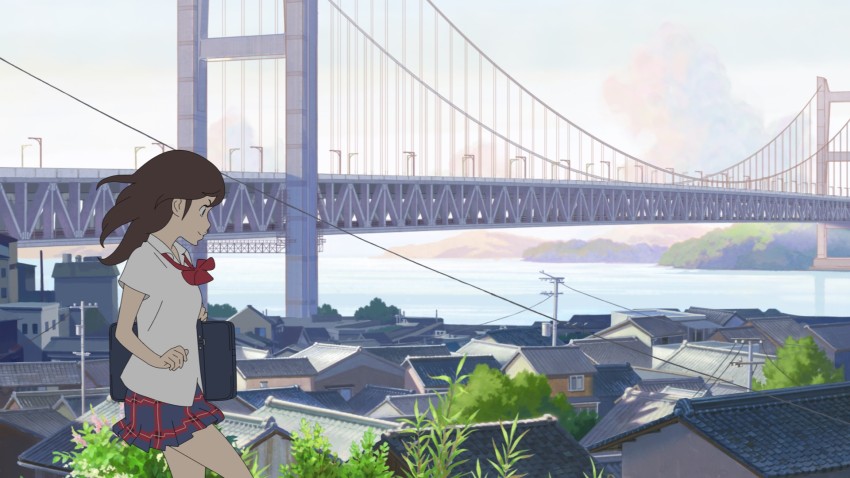Napping Princess
August 11, 2017 · 0 comments
By Andrew Osmond.
 Many anime movies are set in fantastical worlds, many in the real one. Recently, anime movies that aren’t franchise spinoffs have leaned towards real-world settings, contemporary or near-contemporary, from A Silent Voice to Genocidal Organ. But what’s more unusual is to find a film leaping freely between reality and fantasy, like Napping Princess, which hits British cinemas on 16th August.
Many anime movies are set in fantastical worlds, many in the real one. Recently, anime movies that aren’t franchise spinoffs have leaned towards real-world settings, contemporary or near-contemporary, from A Silent Voice to Genocidal Organ. But what’s more unusual is to find a film leaping freely between reality and fantasy, like Napping Princess, which hits British cinemas on 16th August.
The napping princess of the title is a dozy schoolgirl called Kokone. As the story opens, she lives with her father, a car mechanic, in Japan’s Okayama prefecture, south of Tokyo. (To be precise, Kokone lives in in the city of Kurashiki – the obvious landmark is the huge Seto bridge crossing Japan’s Inland Sea to the island of Shikoku. Kokone is getting on with daily life, which seems normal enough. Except that she tends to drift off to sleep rather a lot, and she always dreams of the same place…
This place opens up through her successive dreams. There’s a city entirely based round the automobile industry; this motorised metropolis is threatened from giants who seem made of living lava and are fought by big robots powered by pedalling sailors. There’s a perky magic princess, who resembles Kokone but is younger; this girl is aided by, among others, a talking toy animal and a transforming robot. Notably, while her world draws on both fairy tales and the wild technologies of Japanese fantasy, the wonderland doesn’t seem to have any references to Alice – at least, not that I spotted.
Meanwhile in the “real” world, something shocking happens. Kokone’s father is arrested while he’s visiting his wife’s grave. Trivia: Kokone’s father is called Momotaro, and Okayama is the ‘birthplace’ of the legendary Japanese hero of that name. Just afterward, Kokone has a close brush with strange men invading her family house. They’re looking her father’s tablet (as in electronic device), which supposedly has some valuable code on it. Kokone, though, manages to acquire the tablet and goes on the run, together with her bewildered male friend Morio.
But as they travel across Japan, Kokone’s dreams continue, seeming mirrored in the “real” adventure, in ways that defy explanation. The story which develops involves cutting-edge car technology, Kokone’s father and her late mum whom she never knew…
Napping Princess’s big name is its writer-director Kenji Kamiyama. Many readers will know him as the man who presided over Ghost in the Shell Stand Alone Complex – both the glossy TV seasons and the tie-up movie Solid State Society. Most of his other signature work, such as the film 009 Re: Cyborg, is thematically connected to SAC in one way or another, but Napping Princess feels like a clean break into a different kind of anime. As if to reflect that, it’s not made by Production I.G, the studio with which Kamiyama’s associated, but by a much younger outfit, Signal.MD.
True, Napping Princess is still something of a techno-fantasy, in and out of dreamland. Even the “real” storyline is set in 2020, where a boy can wear oversized VR shades in public without shame. More important to the plot, self-driving technology may be just about to transform society. But arguably this self-driving stuff is essentially just a plot device, a MacGuffin that’s less important than the film’s family themes. In this way, Napping Princess may be closer to a Hosoda film than to Kamiyama’s past work.
However, Princess is set just before the 2020 Olympics. You might reflect that the last Japanese Olympics, in 1964, coincided with another revolution in Japanese transport – the birth of the bullet train, which Kokone is thrilled to ride for the first time.
There’s also one scene in Princess set around a company desk, where an old man argues furiously against the viability of self-driving cars. Some anime fans, watching the scene, may be reminded of a certain legend of anime railing against the use of A.I. to create animation… although that explosion happened too recently to have influenced the film!
Aside from all the techno-trappings, Napping Princess is fundamentally a “crossworld” fantasy, going back and forth from reality to fantasy all through the story. It’s a trick that’s not done very often, partly because it requires a storyline that’s very organised but feels fluidly freeform. The animated precedents include Inside Out, Japan’s Noein and Boy and the Beast, all of which we’ve covered on this blog. Satoshi Kon played similar games in Millennium Actress and Paprika, which were partly influenced by Terry Gilliam’s Brazil (though Brazil’s “reality” is a satirical alt-world).
But these days, the most obvious way to tell these double fantasy/reality stories would be by using games and VR, as the Sword Art Online franchise does. (The latest SAO anime, the Ordinal Scale film, find particularly interesting ways to scrunch reality and fantasy together.) So it’s notable that Kamiyama, who’s been steeped in techno-SF so long, chooses not to use VR worlds in Napping Princess; rather, he just has Kokone sleep her way into fantasy. Then again, one of Kamiyama’s first anime credits was on the backgrounds for the Little Nemo movie…
Andrew Osmond is the author of 100 Animated Feature Films. Napping Princess is in UK cinemas starting 16th August.
Leave a Reply